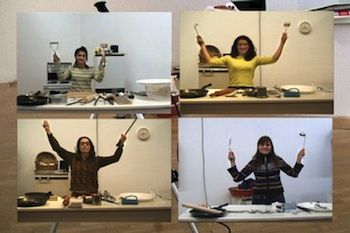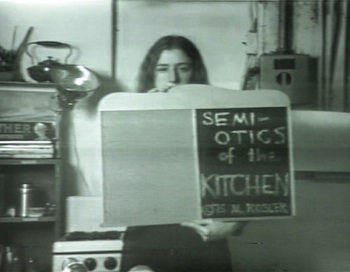In 2003, the Whitechapel Gallery in London invited Martha Rosler to recreate her classic video Semiotics of the Kitchen (1975) as a live performance. She accepted the invitation by holding a casting call for women to reenact the piece; the “audition” would be the public event. Rosler’s documentary video, Semiotics of the Kitchen: An Audition (2011), premiered earlier this week at Electronic Arts Intermix (EAI) in New York.
After the screening, Rosler confessed that she was at first “annoyed and outraged” when asked to restage Semiotics of the Kitchen. Wasn’t it obvious that the piece was meant for video, not a live audience? “My work is about mediation,” Rosler stressed, and the television monitor was one of her tools. Among other misgivings, Rosler worried that the restaging might take on “a nasty, stage-managed quality” opposite the rough-and-readiness of the original. By “withholding” the glitz and glam of Hollywood in Semiotics of the Kitchen, she called attention to popular television depictions of the kitchen. “Boring is a tactic,” Rosler explained. “Everyone hated that piece for a long time.” But the artist, speaking to a packed room at EAI, seemed pleased with An Audition and even a bit charmed by the outcome: a small community of twenty-six women, rotating through a makeshift kitchen, giving their own quirky renditions of Rosler’s 1970s cooking show parody. And then there’s the irony and metaness of it all: the live performance of the video performance became another video.

Martha Rosler, "Semiotics of the Kitchen: An Audition (video still)," 2011. RT 10:26 min. Courtesy Electronic Arts Intermix.
An Audition was but a small part of EAI’s two-hour food-centric program. The original Semiotics also screened with Rosler’s other “kitchen videos,” A budding gourmet (1974) and The East Is Red, The West Is Bending (1977). Watching these, wherein Rosler performs the culture of American cuisine, I was reminded of Michael Pollan’s 2009 piece Out of the Kitchen, Onto the Couch, where he wrote of the theatricality of cooking shows today. In a nutshell, he argued that Americans no longer learn to cook from television but instead how to fetishize food and enact cooking. (Rosler touched on this very topic in a post for ArtFagCity that same year.) “Cooking is a spectator sport today,” the artist decried at EAI. “We’re back to the Benihana model.”
From her book Service: A Trilogy on Colonization (1974-76) to her performance Patriotic Jell-O Salad (2003), Rosler has repeatedly used food as a means to an end. As she put it, food has for her been “a system of production for self-recognition, othering … and class.” But rare is the occasion that she is cast as foodie before feminist, an approach that might have been driven in part by Rosler’s forthcoming publication, The Art of Cooking, a “lost” manuscript about the rhetoric of cooking and art making.
Some thirty-five years after Semiotics of the Kitchen, Rosler is still giving art audiences new ways to think about the social implications of food and kitchens. As she expressed her interest in current trends such as locavorism and urban farming, Rosler made it clear that she recognizes the social shortcomings of these food systems, and the “middle-class bubble” in which they sometimes exist. If we’re lucky, this will be the subject of her next gastro video.
Semiotics of the Kitchen is currently on view at the Museum of Modern Art, New York in the exhibition Counter Space: Design for the Modern Kitchen, reviewed here last September. Browse EAI’s holding of Rosler’s work here.




